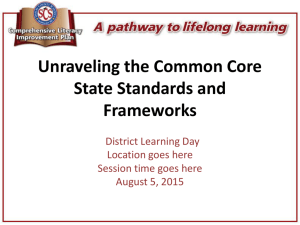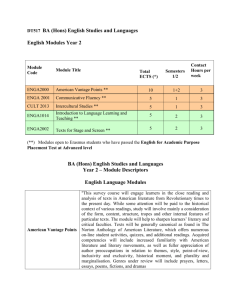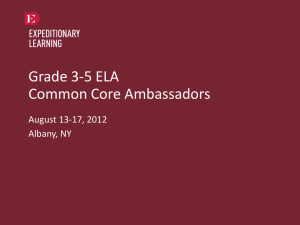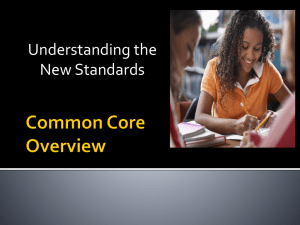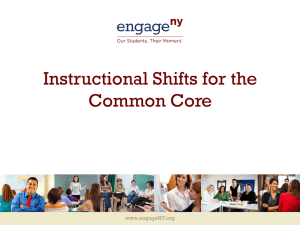Reading Instruction: The 3
advertisement
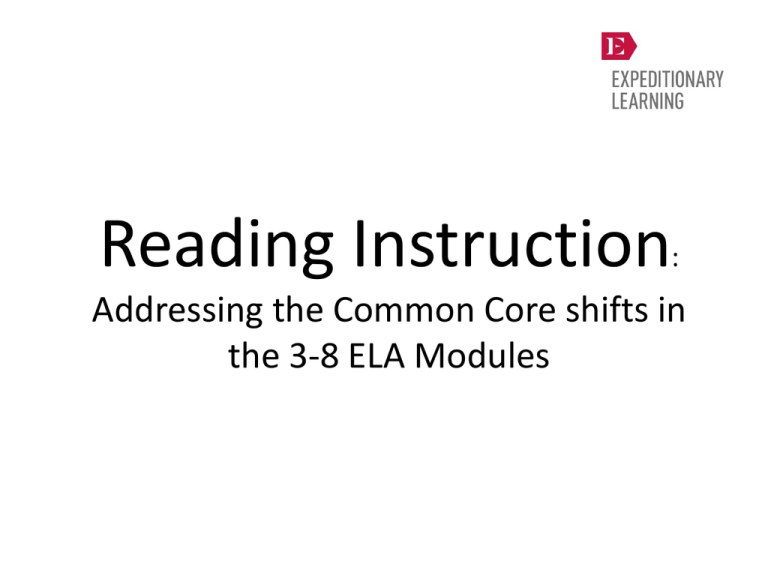
Reading Instruction: Addressing the Common Core shifts in the 3-8 ELA Modules Text Complexity and Academic Vocabulary Shift 1 Regular practice with complex text and its academic language To address this shift in the modules, students: • • • • • Read more texts to build more academic vocabulary. Read and reread small excerpts of complex text at a much slower pace. Think, talk and write about complex text to deepen their understanding. Annotate complex texts. Become more familiar with Tier Two academic vocabulary words and learn strategies to figure out the meaning of unfamiliar words. • Record new academic and domain specific vocabulary. 2 Example: 6M3B, Unit 1, Lesson 2 Lesson Plan: Vocabulary • Focus students on the words evolved (page xiv) and evolution (page xvi). Explain to students that the root of these words is “evolve.” Ask students if they know what it means. • If none of the students knows what it means, explain that evolve means to change and develop over time. Ask students to discuss in triads: • “So what do you think ‘evolved’ means? What does adding ‘d’ do to the word?” • Select volunteers to share their responses with the whole group. Listen for students to explain that adding the “d” makes the word past tense, so evolved means it developed over time. • Refocus students on the word “evolution.” Explain that the suffix “-tion” at the end of the word means the action of, or the process of. Ask students to discuss in triads: • “Put those two parts of the word together. What do you think ‘evolution’ means?” • Select students to share their responses. Listen for students to explain that it means the process of developing and changing over time. Close Reading and Close Reading Guides Close reading is a set of skills that help students to read in order to gain a deep understanding of a complex text. In the modules this close analysis is often supported with a Close Reading Guide a teacher resource to help guide students in a close reading process to deeply understand a text. Students complete text-dependent questions as the teacher guides them through the text. A Close Reading Guide includes questions that: •Support the understanding of the meaning of the text •Support the understanding/knowledge of language in the text •Support the understanding of the structure of a text •Build a knowledge base (i.e. schema that an author of a text may assume readers already have) 4 Example: Close Reading Guide (for teacher reference) Example: Text-Dependent Questions (for students) Balancing Informational and Literary Texts Shift 2 Reading, writing and speaking grounded in evidence from text, both literary and informational Shift 3 Building knowledge through content-rich nonfiction To address these shifts in the modules, students: • Build knowledge about the world by reading different text types including, but not limited to, poems, novels, non-fiction books, academic papers and newspaper articles. • Read compelling literary texts paired with informational texts to engage them in a topic or issue. • Read in order to have something to write about and draw evidence from the texts they are reading to support the claims they make in writing. 7 Research Shift 2 Reading, writing and speaking grounded in evidence from text, both literary and informational Shift 3 Building knowledge through content-rich nonfiction To address these shifts in the modules, before students research a topic, teachers help them begin building background knowledge and domain-specific vocabulary, and spark their interest for inquiry. They then read a variety of informational texts to answer a research question and build expertise in that topic. Throughout the reading process, students write to record the information most relevant to their inquiry, and are shown how to organize the information they gather in journals, on graphic organizers, or in researcher’s notebooks. 8 Independent Reading Shift 1 Regular practice with complex text and its academic language Shift 3 Building knowledge through content-rich nonfiction In order to address these shifts, students must read a high volume of text. Providing students with opportunities to read independently and with tasks that require them to respond to their reading will increase students’ volume of reading and hold students accountable. The modules provide opportunities for independent reading; however, teachers must have independent reading routines implemented that continue alongside the modules. 9


